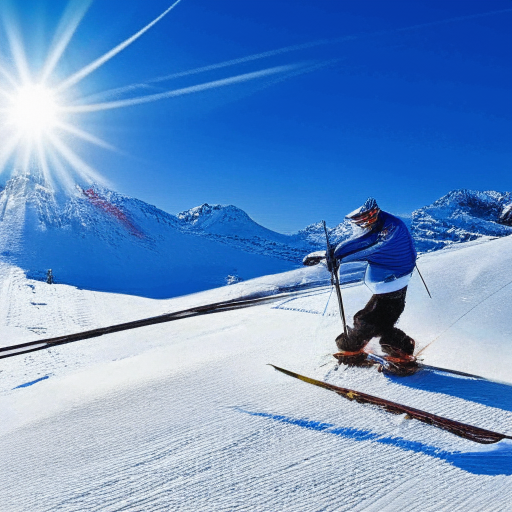Protect Your Vision: A Comprehensive Guide to Understanding and Preventing Snow Blindness
As the captivating winter season envelops the landscape in a blanket of shimmering white, it becomes increasingly important to be aware of the risks posed by outdoor activities in snowy environments. One major concern is snow blindness, a temporary yet profoundly uncomfortable condition caused by excessive exposure to ultraviolet (UV) rays reflecting off the snow. This detailed blog post explores the intricate science behind snow blindness, evaluates how sunlight interacts with snow, and offers practical, actionable strategies for prevention, accurate diagnosis, and effective treatment options. By gaining insight into the underlying causes of this condition and implementing protective measures, we can fully appreciate the beauty of winter while safeguarding our precious eye health.

Understanding Snow Blindness: Medical Definitions and Root Causes
The medical term for snow blindness is photokeratitis, which refers to a temporary injury of the cornea, the eye's outer layer that provides protection. This painful condition often results from prolonged exposure to elevated levels of ultraviolet (UV) radiation, especially from rays that reflect off snow-covered terrains. The brightness of the sun, particularly at higher altitudes where the air is thinner, can lead to significant discomfort and, in some cases, lasting vision issues. Although snow blindness generally resolves on its own within a short duration, comprehending its triggers is crucial for effectively implementing prevention and management strategies that contribute to long-term eye health and well-being.
The Relationship Between Sunlight, Snow, and Eye Health
To fully comprehend the intricacies of snow blindness, it is vital to understand how sunlight interacts with the snow’s surface. Sunlight comprises various wavelengths, including harmful ultraviolet radiation that can damage our eyes. When these rays encounter a snow-covered landscape, snow’s exceptional reflective properties can bounce back up to 80% of these UV rays, significantly amplifying exposure levels. This reflection is particularly evident in elevated regions where the atmosphere's ability to filter UV radiation is notably diminished. As a result, the eyes can quickly become overwhelmed by excessive UV exposure, leading to potential harm to essential components such as the cornea and conjunctiva.
Identifying the Symptoms of Snow Blindness for Prompt Response
The symptoms of snow blindness typically surface several hours after exposure to intense UV light. While individuals may experience varying degrees of severity, common indicators include:
Eye discomfort and pain: Many people report a gritty sensation, akin to having foreign particles lodged in their eyes.
Redness and swelling: The eyes may appear noticeably bloodshot, and the eyelids could swell, showing signs of inflammation.
Watery eyes: The body naturally produces tears to flush out irritants and alleviate discomfort caused by exposure.
Blurry vision: Tasks requiring sharp vision, like reading or driving, may become increasingly difficult due to visual distortion.
Sensitivity to light: An increased sensitivity to light, known as photophobia, often accompanies headaches, making it uncomfortable to be in bright environments.
Visual halos: Some individuals might observe bright rings or halos surrounding light sources, contributing to visual confusion.
Proactive Measures to Shield Your Eyes from Snow Blindness
When it comes to safeguarding your eyes from the harmful effects of UV exposure, taking proactive measures is far more effective than seeking relief after symptoms appear. Here are several practical tips to significantly reduce the risk of snow blindness:
Select appropriate eyewear: Always opt for sunglasses or goggles that block 100% of UV rays when venturing into snowy regions. Look for eyewear marked with UV400 or complete UV protection for maximum safety.
Choose wraparound styles: Selecting sunglasses or goggles that wrap around the sides of your head ensures comprehensive shielding against both direct sunlight and side UV exposure.
Utilize wide-brimmed hats: Hats featuring wide brims or neck flaps provide additional shade, drastically reducing UV exposure to your eyes.
Check the UV Index: Before embarking on outdoor activities, consult the local UV Index, which indicates daily UV exposure levels. Exercise caution to limit sun exposure during peak hours, typically between 10 AM and 4 PM.
Apply sunscreen effectively: Although it may seem unrelated, applying sunscreen around your face and eyes can significantly diminish UV exposure, enhancing your overall protection.
Take regular breaks indoors: If planning to spend extended periods in snowy environments, make it a routine to take breaks indoors, allowing your eyes to rest and recover from bright light exposure.
Effective Relief and Recovery Strategies for Snow Blindness Symptoms
If you find yourself experiencing the symptoms of snow blindness despite preventive measures, several strategies can help alleviate discomfort and promote recovery:
Seek shade immediately: Move to a darkened environment or indoors to shield your eyes from further UV exposure.
Remove contact lenses: If you wear contact lenses, take them out to prevent additional irritation and facilitate proper healing of your eyes.
Apply cold compresses: Placing a cold, damp cloth over closed eyes can effectively soothe discomfort and reduce any swelling.
Utilize artificial tears: Over-the-counter artificial tears can provide temporary relief, keeping your eyes lubricated and alleviating dryness associated with snow blindness.
Avoid bright lights: Minimize exposure to intense light sources, including screens and overhead lighting, to reduce the effects of photophobia during recovery.
Rest your eyes diligently: Engage in activities that place minimal strain on your vision, avoiding reading or screen time to give your eyes the vital time they require to heal.
Determining When to Contact a Healthcare Professional for Snow Blindness
In most cases, the symptoms of snow blindness begin to diminish within 24 to 48 hours as the cornea starts to heal. However, it is crucial to seek medical attention if symptoms worsen or persist, as delays in treatment could result in complications or secondary infections that may affect your vision.
Experiencing snow blindness can significantly detract from the enjoyment of winter activities, but with informed knowledge and precautionary measures, we can greatly mitigate the risks while immersing ourselves in the breathtaking beauty of snowy landscapes. Maintain awareness of UV radiation levels, take frequent breaks in shaded areas, and prioritize wearing protective eyewear. If symptoms arise, seek relief promptly and consult a healthcare professional if necessary. By putting eye safety first, you can fully enjoy the winter wonderland and create cherished memories without jeopardizing your vision. Embrace your winter adventures with caution!
The post Snow Blindness: Understanding Its Causes and Effects appeared first on Survival Bite.
The Article Snow Blindness Causes and Effects Explained Was Found On https://limitsofstrategy.com
The Article Snow Blindness: Understanding Its Causes and Effects First Appeared ON
: https://ad4sc.com


This post sheds light on an often-overlooked aspect of winter enjoyment that many may not consider until it’s too late. Having recently experienced a day of skiing where I forgot to wear proper eye protection, I can confirm just how debilitating snow blindness can be. The unique reflections off the snow create an environment that, while beautiful, poses serious risks to our eye health.
Your exploration of snow blindness offers a vital reminder for anyone who loves outdoor winter activities. It’s fascinating how much we often overlook the effects of UV exposure in snowy conditions, assuming that because temperatures are low, our eyes may be shielded from harmful elements. As you succinctly outlined, photokeratitis can indeed be a debilitating consequence of not taking proper precautions, even if it’s temporary.
You’ve hit the nail on the head about UV exposure sneaking up on us in winter wonderlands. It’s a classic case of “out of sight, out of mind”—we bundle up so well against the cold that we forget the sun’s still got its laser focus on us, just bouncing off all that bright, white snow.
Thank you for your thoughtful comment! If you’re looking to further protect your eyes during your winter adventures, you’ll find some great tips and gear recommendations in this helpful guide.
https://oldicom.net/octopus